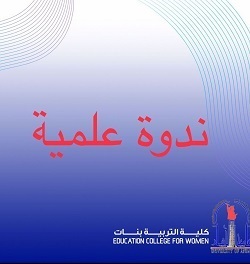
Scientific article entitled Genocide in the Postmodern Era
Genocide in the Postmodern Era
Inst. Dr. Elaff Ganim Salih
English Department/ College of Education for Women
This essay turns away from feminist interpretations of wartime rape, arguing that women in some of the plays written in the twentieth century are attacked in such conflicts not because of their gendered identity but for political reasons. It deals with The general meaning of genocide is the termination of a race of people for different political, racial, and religious aims and purposes. This type of extinction of people takes different forms nowadays. One of these forms is rape, which spread in the twentieth century. Thus, this essay explores the instrumentalization of sex in wartime in service of larger political and military purposes. It is a rape not for sexual gains but for strategic aims, which annihilates a distinctive group of people. This type is characterized by committing actual physical rape that ends with the murder of the victims but it is labeled as a genocidal rape, “it is rape unto death, rape as massacre, rape to kill and to make the victims wish they were dead” (Russel-Brown 2003, 350). Rape in this way functions as an act of genocide.
This type of rape from a contemporary strategic perspective is different from the previous natural, biological, and feminist ones. Thus, wartime rape in this sense is not a consequence, but a calculated and systematic weapon used for genocide. (Gottschall, 2004) It is organized and that orders act as a driving force of the genocide. It exceeds dishonoring into ethnic termination.
In genocidal wars, rape cannot be called accidental or aberrant but is organized by a group in their attempt to eliminate their enemy. It is encouraged by certain motivations by the organizers of the genocide as a form of murder itself to urge their troops onward to violence to reach higher goals. Surprisingly, it is a wide spread phenomenon in the new wars. As a rape , it is not a misogynist or hegemonic in its nature but is a weapon of war, a violent act perpetrated against a member of a group with the intent of terminating that group. There are many plays written in the twentieth century about this war issue such as Colleen Wagner’s The Monument( 1995). The rape depicted in this play is not misogynist or hegemonic in its nature but is a weapon of war, a violent act perpetrated against a member of a group with the intent of terminating that group.
Colleen Wagner’s The Monument (1995) is a Canadian play which talks about many themes concerning war issues such as genocidal rape, scapegoating, moral choices, reconciliation, and forgiveness in an unnamed setting and an unnamed war. The main focus of the analysis of Wagner’s play is on wartime rape, which is adopted as a strategic weapon of genocide. The date of the play goes back to the late twentieth century, which witnessed the waging of tremendous civil wars and countless genocides in Bosnia, Croatia and the African countries such as Rwanda, Democratic Republic of the Congo (DRC), Darfur, Sudan …etc. As a dramatist, Colleen wrote the play after travelling to many countries that suffered civil unrest and genocide. Richard Rose, the director of the play, admits that in The Monument “was anger and determination to give order to the emotional chaos of this story from the Yugoslavian civil war and the forty-two other wars that year and all wars since time immemorial” (Wagner 1995, iv). Although The Monument’s setting carries universal themes related to many conflicts in the twentieth century, it is haunted by the Rwandan genocide. Moreover, as evidenced by the events in Bosnia and Rwanda, “rape and other acts of sexual violence can be used to commit genocide” (Russell & Brown 2003, 373).
The actions of rape committed in the play are an orchestrated strategic weapon and part of a wider genocidal project not a consequence of war as Gottschall defines as “distinct patterns of rape by soldiers at rates that are much increased over rates of rape that prevail in peacetime” (2004,129). Thus, the main focus is directed towards those acts that often end with the actual termination of the lives of the victims. These acts of rape are exposed by the two main characters in the play; the main perpetrator, Stetko, a young soldier convicted of war crimes, and Mejra, the mother of one of his 23 victims, in their journey back to the place where he raped, killed and buried her daughter. Through the events of the play, Mejra orders Stetko, the perpetrator to dig up the victims’ bodies to try to know the truth of their rape and genocide and to reclaim them by building a monument with their decomposed bodies to memorize the victims. Thereby Wagner’s play is an endeavor to dramatize this bitter truth of war by the action of constructing an artistic epitaph in the dramatic world and in the play itself to “build a monument to the truth about war” (The Monument, 1995:75)
Consequently, wartime rape that is strategic and genocidal in its nature functions like traditional weapons such as guns, bullets, and bombs. It is a sexual form of violence not a violent form of sex that regulates power on the national level between conflicted groups.
References:
- Russell-Brown, Sherrie L. “Rape as an Act of Genocide”. Berkeley J. Int'l L. 21 (2003): 350. Internet Source.
- Gottschall, Jonathan. “Explaining Wartime Rape”. Journal of Sex Research, 41.2 (2004):129-136.http://dx.doi.org/10.1080/00224490409552221.Internet Source.
-Wagner, Colleen. The Monument. Playwrights Canada, 1995. Print




